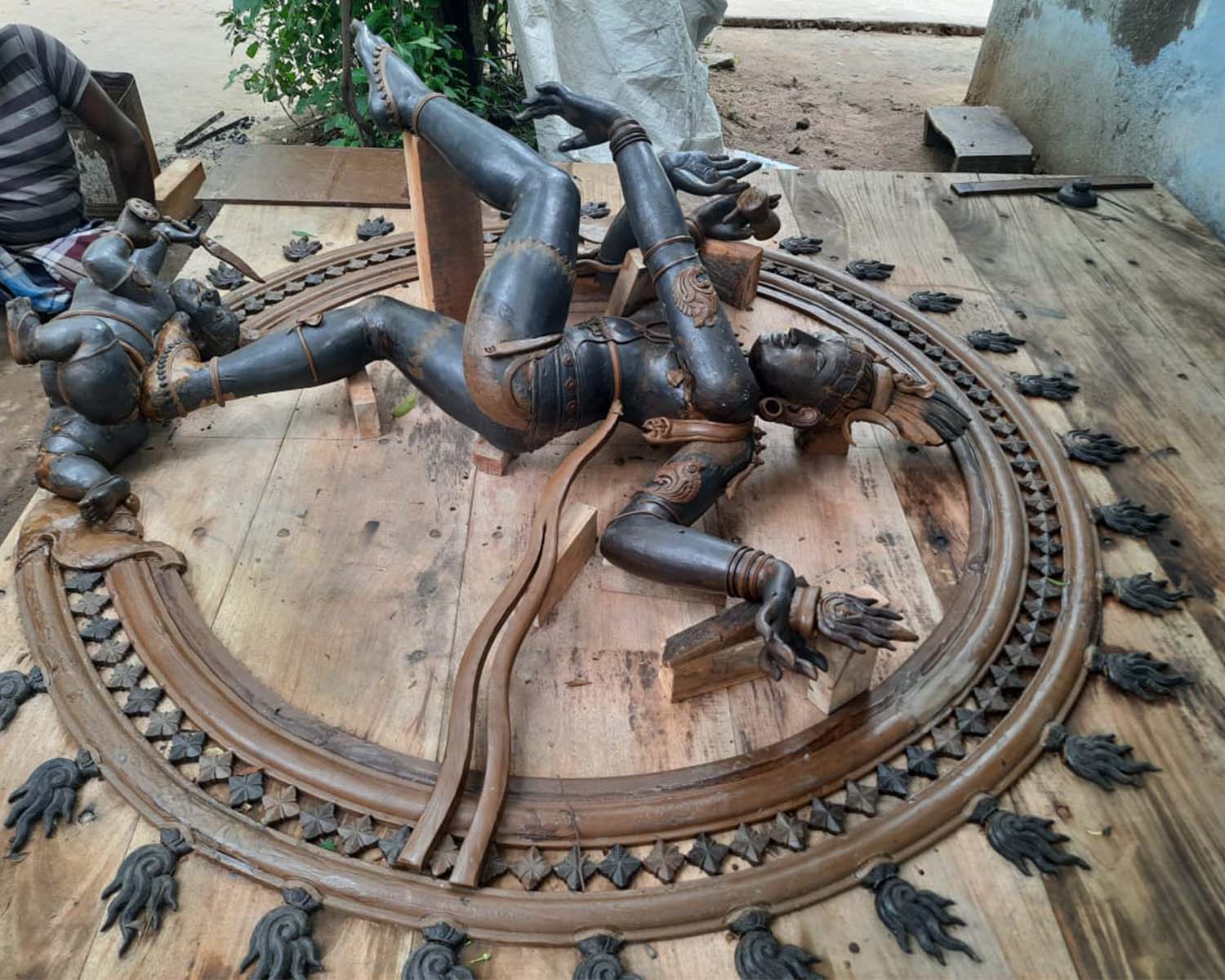28-ft Nataraja Sculpture from Tamil Nadu to Grace G-20 Venue in Delhi
Context
A 28-foot Nataraja statue from Swamimalai, a small village in Tamil Nadu’s Thanjavur district famous for its bronze sculptures, was transported by road on Friday in preparation for the G-20 Leaders’ Summit, which will take place in New Delhi next month.
What is the Nataraja Statue?
A famous portrayal of the Hindu god Shiva as the cosmic dancer can be witnessed in the Nataraja sculpture. Hindu culture and philosophy attach great symbolic and spiritual value to this sculpture. It shows Shiva performing the “Tandava,” a dynamic and rhythmic dance that represents the universe’s cycles of creation, preservation, and destruction.
How is Shiva Depicted in the dance form?
- Shiva is shown as Nataraja, the cosmic dancer who dances creation, preservation, and destruction. Shiva is a Hindu deity who is believed to be a brilliant dancer.
- The two most well-known manifestations of Shiva’s dance are the Ananda Tandava (dance of bliss, the strong form of dance), which is connected to the destruction of worn-out worldviews—weary attitudes and lifestyles, and the Lasya (the gentle form of dance), which is connected to the creation of the world. The Lasya and the Tandava are just two facets of Shiva’s nature since he destroys to create and then rebuilds.
- With its style and proportions created per Hindu writings on art, the sculpture is emblematic of Shiva as the lord of dance and dramatic arts. Shiva is usually depicted dancing in a Natya Shastra pose, holding Agni (fire) in his left backhand, the front hand in gajahasta (elephant hand) or danda hasta (stick hand) mudra, the front right hand holding a wrapped snake in abhaya (fear not) mudra while pointing to a Sutra text, and the backhand holding a musical instrument, usually an Udukai.
- His fingers, ankles, neck, face, head, ear lobes, clothes, and other body parts are all adorned with various symbolic objects, depending on the historical era and geographic location.
- .He is depicted as being encircled by a ring of flames, standing on a lotus pedestal, raising his left leg (or, in other instances, his right leg), and balancing or trampling over a demon represented as a dwarf (Apasmara or Muyalaka), who represents spiritual ignorance.
- The swirling hair, which is fanned out behind his head in thin strands like a fan, captures the energy of the vigorous dance.
What does this Nataraja History Symbolize?
- Tandava and Lasya: Nataraja’s dance represents the never-ending cycle of creation and annihilation by embodying both the Tandava (vigorous, destructive) and Lasya (gentle, creative) parts of Shiva’s nature.
- Dwarf Demon: Shiva’s victory over spiritual ignorance, which opens the door for enlightenment, is symbolized by Nataraja’s foot-crushing the dwarf demon (Apasmara or Muyalaka).
- River Ganges: The river Ganges that emerges from Nataraja’s hair represents the cleansing and life-giving properties of water, uniting the physical and spiritual worlds.
- Chidambaram: The dance of Nataraja, which represents the centre of the universe and has cosmic significance that transcends physical limits, is performed in Chidambaram.
- Flaming Circle: Nataraja performs his dance within a frame of flames that is either circular or elliptical, representing the cosmic fire that both produces and consumes the cosmos, symbolizing both creation and destruction.
- The gesture of Hands: Nataraja’s hand gestures have symbolic components. A drum (damaru) stands for rhythm and time, fire for creation and destruction, and the raised foot for freedom from ignorance.
What is the historical background of the statue?
- Nataraja sculptures can be seen in historic rock-cut temples that date back to the sixth century CE, including the Ellora and Badami Caves.
- Pallava Period: Nataraja rose to popularity in Tamil Nadu at this time and was associated with cosmic cycles of creation and destruction.
- Chola Bronzes: Intricate Nataraja bronzes were produced under the Chola dynasty (10th century), which solidified the representation and highlighted the dynamic attitude and meaning.
What is the spiritual and Philosophical Significance of the artwork?
- Cycle Of Life: Nataraja’s dance reflects the cyclical aspect of life, in which creation is followed by preservation, then annihilation, and the cycle is repeated.
- Unity of All: Nataraja represents the harmony of various facets of life, including creation and destruction, joy and sorrow, and birth and death, within the cosmic dance.
- Liberation from Ignorance: Nataraja’s dance has a spiritual connotation that represents emancipation from ignorance, pointing followers in the direction of self-realization and enlightenment.
- Transcendence: Nataraja’s dance transcends temporal and physical boundaries, luring viewers to recognize the deeper spiritual truths hidden behind outward manifestations.
International Recognition for Nataraja Sculpture
- The G-20 Leaders’ Summit location in New Delhi will include a 28-foot Nataraja monument in front of it. The Nataraja sculpture in Swamimalai, Tamil Nadu, is thought to be the tallest Nataraja sculpture ever created. It is made of eight metals (Ashtadhatu). It is intended to serve as a cultural and symbolic addition to the G-20 Leaders’ Summit, which will take place in New Delhi on September 9 and 10 at Bharat Mandapam.
- At the Geneva-based CERN, the European Center for Research in Particle Physics, a 2-m statue of the dancing Shiva was unveiled in 2004. The statue, which represents Shiva’s cosmic dance of creation and destruction, was presented to CERN by the Indian government to honour that country’s long relationship with the research facility.





